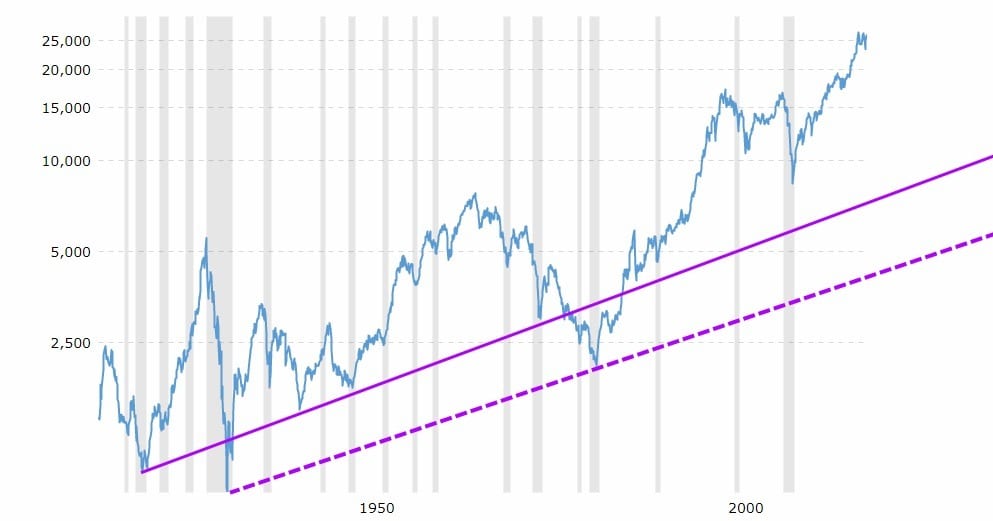Permabear Chronicles: Defying the Eternal Optimist’s Dream
Dec 31, 2024
In investing, stubbornness and a refusal to adapt to changing market conditions can be a recipe for disaster. This is particularly true for those who adopt a Permabear stance, a consistently pessimistic mindset about the future direction of the markets, regardless of prevailing conditions or trends. This kind of stubbornness, akin to a chess player refusing to adapt their strategy despite the changing state of the board, can lead to significant financial losses.
Being a Permabear is akin to having a death wish in the financial markets. It’s a special kind of stupidity and stubbornness that even a thousand hard slaps of reality cannot alter. This short-sighted thinking, driven by an unyielding belief in impending market doom, often leads to missed opportunities and poor investment outcomes. A simple examination of any long-term chart will prove once and for all that being a Permabear is never going to pay off. No long-term chart can demonstrate that taking a bearish stance has ever paid off in the long run.
For instance, the 100-year Dow Jones Industrial Average chart clearly illustrates the market’s upward trend over time. Regardless of the trend line, the chart shows that the market tends to rise over the long term, debunking Permabear’s constant prediction of doom and gloom.
It’s important to remember that investing is not always about being right but adapting to the market and making informed decisions based on current conditions. Stubbornness and a refusal to adjust, traits often found in Permabears, are not conducive to successful investing. As the saying goes, “The market can stay irrational longer than you can stay solvent.”
Like chess, investing requires flexibility, adaptability, and a willingness to change one’s strategy based on the state of the board. By understanding the dangers of a Permabear mindset and adopting a more flexible approach, investors can navigate the turbulent waters of the financial markets and thrive amid the chaos.
Navigating the Perilous Seas: Mastery Beyond the Folly of Fear
The financial markets present a vast array of opportunities, requiring insight and the courage to rise above the chaos. Permabears, those perpetual pessimists trapped by an unyielding expectation of decline embark on a perilous journey fraught with self-imposed pitfalls. Their chronic scepticism, resistant to the ever-evolving currents of the market, often culminates in substantial losses and the looming shadow of bankruptcy.
Clinging stubbornly to ineffective strategies, they repeat the same misguided actions, mirroring the essence of futility—expecting transformation without change. This relentless adherence to a failed approach is equivalent to sailing a broken ship into stormy waters, hoping the storm will yield. Such intransigence endangers their financial well-being and serves as a cautionary tale of rigid thinking in a dynamic landscape.
In stark contrast, the path to market mastery is elegantly straightforward. It demands a disciplined focus on the fundamental forces that truly shape trends. By attuning to mass sentiment, investors gauge the market’s collective psyche while keenly analyzing extreme patterns through technical analysis, providing a crystalline view of potential shifts. Prominently displayed on the charts, these factors cut through the haze of speculation, offering clear guidance.
It’s imperative to recognize that much of the noise—particularly the relentless barrage of news—holds little substantive value. One could argue that even the most mundane essentials of life possess greater significance, serving tangible purposes daily. News is often sensationalized, and fear-mongering can obfuscate reality, leading investors astray with distractions rather than insights.
Guarding against the purveyors of fear is not just wise—it’s essential. Those who wield fear as a tool for manipulation deserve no audience; they should be firmly dismissed from our circles of influence and barred from infiltrating our thoughts. Fear enriches only its merchants, those who profit handsomely from the anxieties they stoke. Investors who succumb to such tactics risk far more than fleeting losses—they stand to forfeit their clarity, composure, and, ultimately, their financial foundations.
True success in the markets is forged through the courage to defy fear, the wisdom to ignore the clamour of irrelevance, and the finesse to focus on what genuinely matters. By embracing simplicity and discarding the cacophonous distractions, one doesn’t merely survive the tumultuous financial seas—but commands them with dominance and grace. This approach isn’t just prudent; it’s a formidable stance of empowerment, a testament to the strength of clarity and the elegance of strategic foresight.
Seizing Opportunities Amid Crisis
In times of crisis, such as the current coronavirus pandemic, it can be wise to nibble at stocks with a long-term perspective. Rather than investing all your funds at once, consider supporting in smaller increments to average your entry price and protect against dips in the stock market.
At the Tactical Investor, we focus on longer-term plays that typically span several months. However, in times of crisis like these, we’re seeing a surge in the potential for huge profits, so our time frames have lengthened accordingly. While the short-term market may seem like a bloodbath, it’s also a breeding ground for exceptional opportunities that can herald the next bull market.
It’s easy to invest when everything seems rosy, but unfortunately, that’s when most assets are already overpriced. When times appear bleak, that’s precisely when the best deals can be found. So, consider taking a closer look at the market during these volatile times, and you may discover some hidden gems. Tactical Investor Update March 18, 2023
Fear & Folly: Decoding the Merchants of Doom
Fear is the sharpest weapon in the arsenal of financial forecasters who thrive on market panic. Figures like Marc Faber and Jim Rogers wield it with a mastery that turns mere speculation into mass hysteria. Faber, the voice behind the Gloom, Boom & Doom Report, anchors his entire narrative in negativity—66% of his publication is steeped in forecasts of impending disaster. He understands herd psychology, preying on uncertainty to nudge investors toward rash decisions, abandoning reason for the fleeting comfort of impulsive action.
Yet, Faber’s grim pronouncements crumble under scrutiny. His track record reveals a pattern of consistent inaccuracies, exposing his reliance on sensationalism rather than data. Since 2009, Faber has tirelessly predicted the “mother of all crashes,” yet the only thing crashing is his credibility. Investors who ignored his warnings during the bull market have enjoyed significant gains, while his predictions linger in unfulfilled doomsday fantasies.
In a telling exchange on CNBC, critics challenged Faber’s unrelenting pessimism. He dismissed his detractors when accused of being perpetually wrong, claiming:
“I laugh at it… I’m used to people like you who always attack me.”
Such deflection underscores the unyielding stance of a “permabear”—entrenched in negativity that even minor market corrections are spun as vindication of apocalyptic foresight.
Doomsday Decoded: The Truth Behind Fear-Driven Forecast
Jim Rogers, too, beats the drum of disaster, repeatedly forecasting catastrophic market crashes. His dire warnings do more than predict—they often catalyze panic. Gripped by fear, investors rush to liquidate their assets, sometimes bringing about the downturn they sought to avoid. Rogers’ narrative amplifies the cyclical nature of fear, proving that the markets are as much about psychology as they are about numbers.
To blindly follow such merchants of doom is to court financial disaster. Their proclamations demand rigorous scepticism and analysis. Investors must sift through their hyperbolic rhetoric, extracting useful insights while discarding the noise. Rejecting their warnings outright is as dangerous as swallowing them whole. Wisdom lies in balance—in discerning which fears are justified and which are manufactured to manipulate.
Faber once remarked, “When all is over, people will love me for having warned them to have all their money in stocks.” But the reality is less poetic. An unrelenting bearish stance can blind even the shrewdest investor to market opportunities. The resilient market has continually defied such pessimism, rewarding those who temper scepticism with strategic optimism.
This narrative serves as a powerful reminder that while scepticism has its place, an unwavering bearish stance may blind one to the opportunities that exist within the market’s resilient fabric.
Case Study 1: The Perils of Being a Permabear
Investing is an art, not a science. It’s meant to be enjoyed, not feared. A prime example of the perils of fear-based investing was the COVID crash of 2020. Those who let fear dictate their decisions during this time of uncertainty often found themselves on the losing end when the markets rebounded.
Interestingly, despite the strong market recovery, many investors remained cautious, a testament to the power of herd psychology. This phenomenon, where collective sentiment influences individual behaviours, can lead to irrational decision-making, particularly during market volatility.
Diving into historical case studies, we unravel the dismal outcomes for those embracing a permanent bearish stance. This journey through financial history exposes the severe losses incurred by those who yielded to fear.
Case Study 2: Conquering the New Bull Market
The bull market that began in 2009 shattered old rules. Technical analysis, once a reliable guide, became a risky gamble, leaving 99% of traders blindsided by the new market realities. The landscape no longer obeys predictable peaks and troughs—certainty is an illusion.
Yet, a deep-rooted pessimism still lingers. Investors, wary of pullbacks—no matter how minor—mistake every dip for an impending crash. This fear is a costly illusion, born from doubt rather than data.
Our strategy dismantles this mindset. Holdings that once wavered in the red now surge confidently into profit. This isn’t luck—it’s about executing the adage: “Buy when blood flows in the streets.“ Easy to say, harder to do. At the moment, most falter, clinging to the sidelines instead of seizing the opportunity.
To truly master this bull market, abandon stale strategies and dismiss the noise of naysayers. Fortune belongs to the bold and the perceptive. Embrace the market with fearless clarity, rejecting fear-driven narratives, and you don’t just follow the trend—you dictate it.
Case Study 3: The 1987 Crash
The 1987 crash, also known as Black Monday, is a classic example of the dangers of succumbing to fear. On October 19, 1987, the Dow Jones Industrial Average fell by 22.6%, the most extensive one-day percentage loss in history. The crash was triggered by many factors, including a rapidly rising market, high interest rates, and computerized trading that accelerated the sell-off.
Many investors, overcome by fear, sold their stocks in a panic, resulting in massive losses. Permabears, those who are consistently pessimistic about the market, were vindicated in the short term, but their victory was short-lived. The market began to recover by the end of 1987; by 1989, it had regained all of its losses. Those who panicked and sold their stocks during the crash missed this recovery.
Case Study 4: The Dot-Com Bubble Burst of the Late 1990s
Permabears who had warned of an impending crash seemed to be proven right, and fear again gripped the markets. Many investors panicked and sold their stocks, leading to significant losses. However, those who held onto their investments or invested in companies with solid financials and business models could weather the storm.
In the aftermath of the crash, many tech companies, such as Amazon and Google, emerged more robust and have since become some of the most valuable companies in the world. This serves as another reminder of the dangers of fear-based investing. Even in the face of market downturns, making investment decisions based on rational analysis rather than fear is crucial.
















